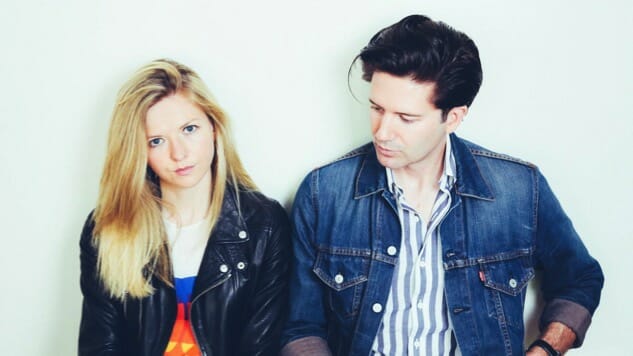
Still Corners’ Greg Hughes is trying very hard to think of a specific filmmaker he likes. It’s Peter Weir, a name that he’ll shout out moments later, along with praise for the director’s dense catalog of films—many, which Hughes says matches the tone of his band’s music. But at the moment…he’s stumped.
“We have memory!” he insists. “But I think we’re being ruined by the internet. You don’t have to remember anything anymore.”
“I think I know one telephone number,” consoles bandmate Tessa Murray, agreeing with his assessment with a laugh. “Mine!”
The internet may be responsible for drip-feeding us knowledge via clicks instead of dredged up memories, but neither member of the band can deny the power it has had on their career. After two albums with Sub Pop, the duo opted to forgo the traditional distribution deal and release album number three, Dead Blue, on their own label. Thanks to digital marketplaces, that no longer seems like such a pie-in-the-sky proposition.
They also left London, where they’ve lived for over a decade, in favor of Deal, a tiny town, located the next county over in Kent. Both say that the bucolic atmosphere, where there was little do but haunt the local pub and go for walks, helped them focus completely on the job at hand, writing and recording for the better part of a year.
“It was this seaside town,” says Hughes, setting the scene. “It was really cool place. There was not much going on. It was very beautiful we were right on the sea. We had this amazing house right on the beach. That may have been why it took so long.”
He pauses to laugh. Since recording, he and Murray have relocated to Austin, Texas, so it’s clear the multi-instrumentalist is enjoying this opportunity to reminisce.
“I have this theory that it doesn’t actually exist,” he continues. “It’s a dream world and time just sort of stops there. It’s on the edge of England. You can see France on a clear day. It’s amazing. You feel like you’re on the edge of the world. Nothing is going on and people are all different and friendly. So we just thought, hmm, let’s spend a few more months on this album.”
Other than a desire to add some tension to their sound, both Murray and Hughes admit they didn’t go into their sessions with any preconceived notions of what they were looking for. Beginning with their 2008 debut EP Remember Pepper, Still Corners’ chief concern has been with the dreamy, their music playing more like sonic accompaniments to say, French New Wave films than traditional songs. Still Corners’ 2013 sophomore album Strange Pleasures added more beats and reverb, many of its tracks sounding alternate dimension radio-ready. But still their music played on the light side, as though lobbying to become the very definition of dream pop. To help them channel their inner darkness, the pair employed more guitar, scattering Chromatics-like hooks around “Bad Country” and “Lost Boys.” (“It started off as Beach Boys,” Murray reveals of the track.) They also channeled the energy of their former hometown.
“The dark city streets of London come out of that,” Hughes explains. “It was 12 years for me. Suddenly we’re in this other place that’s more of a nature place, but you’re still conjuring up all these images and they’re all still really present in your imagination. So a dark city street record made in a sleepy seaside town. But through the Still Corners filter.”
It might be easy to place the title Dead Blue in the same league as say, Stranger Things (a connection no doubt nurtured by the album’s 1980s-inspired artwork). And certainly many of the textured synths the pair employees would help further the parallelism. But Hughes says that the phrase has its origin in local slang rather than SciFi.
“I think it’s an expression when we say ‘dead blue’ we mean it’s ‘really blue,’” he clarifies. “Dead gorgeous. That kind of thing. It was the window out from the room we were working on. It looked directly to the sea and it was very blue.”
But perhaps the biggest transformation has been Murray’s vocals, pushed to the forefront of the band’s recordings. As Still Corners’ de facto frontwoman, her eerie soprano has always been a major part of the band’s aesthetic. But now she sounds in control—and perhaps a bit dangerous.
“It’s been quite fun to experiment with that and use different parts of my voice,” Murray confesses. “And certainly in a live context generally the newer ones are easier to sing live. The early ones are whispery and quiet. It’s almost an unnatural way of singing when you’re in front of a whole band in a huge venue. I guess it was a conscious decision. We really experimented and pushed things further. It was good. But I wouldn’t be surprised if the next one is different again.”